FEATURES|COLUMNS|Buddhist Art
Alternate Realities in the Paintings of Wakana Kimura
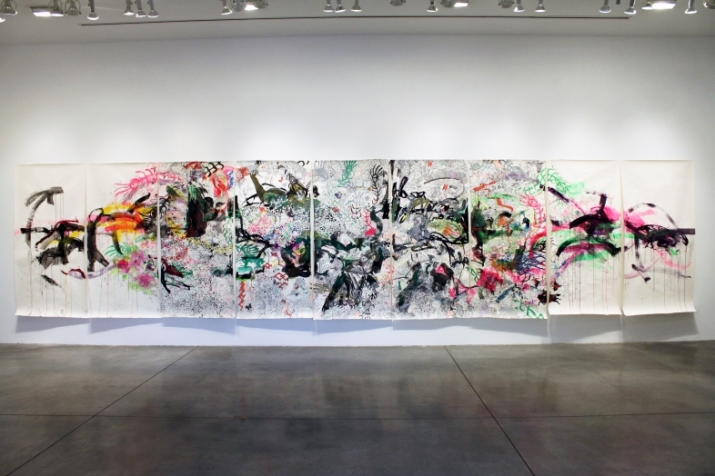 CHARACTER, by Wakana Kimura. 2011, mixed media, nine panels. Image courtesy of the artist
CHARACTER, by Wakana Kimura. 2011, mixed media, nine panels. Image courtesy of the artistAt a distance, the monumental nine-panel painting appears to be an explosion of black calligraphic brushstrokes and electric neon-toned splashes. Wakana Kimura’s (b. 1978) work CHARACTER is a dynamic yet elegantly balanced exploration of the energy expressed in line and color, one that pays homage at once to the Abstract Expressionist movement of the West and the bold Zen Buddhist brush painting of her home country, Japan. Seen up close, however, the painting reveals an alternate reality. Almost the entire surface of this massive work is packed full of lions, peacocks, dragons, and phoenixes, as well as men on horseback, elegant court ladies, and lavish chrysanthemums, cherry blossoms, and other blooms. Surrounding and connecting these motifs are delicately drawn patterns of flowers, fish scales, and swirling waves, so that every inch of the central sheets of the painting is filled. The details, all borrowed from traditional Japanese scroll paintings, woodblock prints, and kimono, swirl together in a tornado-like, artistic mash-up, both abstract and figural, Western and Eastern, producing a mixed-media work that challenges perceptions of reality and illusion.
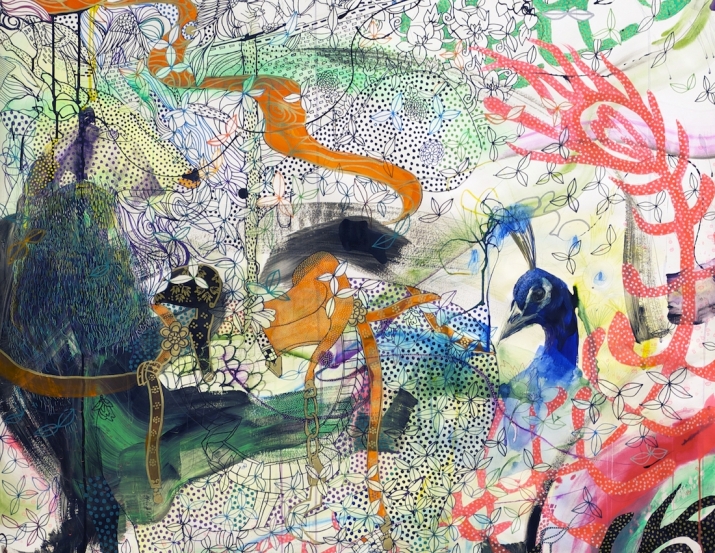 CHARACTER (detail), by Wakana Kimura. 2011, mixed media, nine panels. Image courtesy of the artist
CHARACTER (detail), by Wakana Kimura. 2011, mixed media, nine panels. Image courtesy of the artistAs with this work, many of Kimura’s larger paintings only reveal their true, more profound nature upon closer inspection and deeper reflection, raising questions about the nature of reality as shown from different perspectives. This approach undoubtedly arose from shifts in Kimura’s own artistic and cultural perspectives over the last decade working as a Japanese artist in the United States. After receiving a bachelor of fine arts degree from Tokyo University of the Arts (2002), Kimura moved to Los Angeles and enrolled at Otis College of Art and Design, receiving her master’s in fine arts in 2011. For much of her time as a student, she studied Western abstraction, focusing in particular on color, tone, and mark-making. Searching for something new in her work as she approached the end of her studies, she began to look to Japan’s rich artistic heritage, and started to incorporate Japanese motifs into her art as her “markings.” Since then, many of her larger works have been built up from an assemblage of traditional Japanese imagery and patterns, and increasingly, with the addition of deities and symbolism drawn from Buddhist iconography.
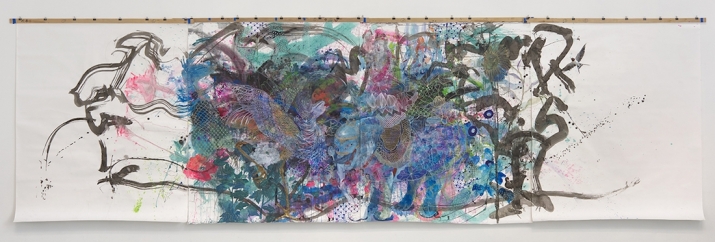 One trifle-beset night, t’was the moon, not I, that saw the pond lotus bloom, by Wakana Kimura. 2015, mixed media, four panels. Image courtesy of the artist
One trifle-beset night, t’was the moon, not I, that saw the pond lotus bloom, by Wakana Kimura. 2015, mixed media, four panels. Image courtesy of the artistIn her recent painting One trifle-beset night, t’was the moon, not I, that saw the pond lotus bloom (the title taken from a poem by the Japanese Buddhist priest Saigyo [1118–90] and translated by David McLeod), Kimura conceals a Buddhist deity within her vividly colored abstraction. At the heart of the four-panel, horizontal painting is an elephant, upon which sits the bodhisattva Samantabhadra (J. Fugen), a deity who is typically depicted along with the bodhisattva Manjushri (J. Monju) on a lion, both flanking the Buddha Shakyamuni. Samantabhadra is considered by many Buddhists to represent action and practice, while Manjushri represents spiritual insight. In this dazzling painting, amidst strong black calligraphic lines and washes of turquoise and lapis pigment, Kimura outlines the details of the elephant, the deity’s robes, and the striations of the lotus petals on his throne with the painstaking precision of the Buddhist artists of old who illustrated Buddhist sacred sutras. By covering the creature’s head and legs in tiny dots and embellishing his body with lotus flowers, she renders the elephant translucent and ethereal, a ghost-like element within an abstract composition. On his back, Samantabhadra, depicted simply with pencil-thin lines, sits perfectly serenely amidst the energetic swirl of strokes and pigment. In a single-sheet work, Shika Mandara, or “Deer Mandala,” a large and a small figure of a deer, representing the deity of the Kasuga Shrine in Nara, similarly appear almost like silvery phantoms against the dynamic strokes of her calligraphic outburst, positioned somewhere between the real and the illusory.
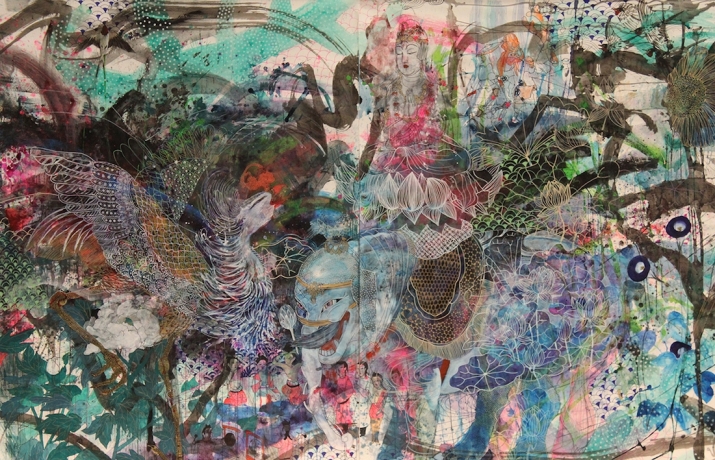 One trifle-beset night, t’was the moon, not I, that saw the pond lotus bloom (detail), by Wakana Kimura. 2015, mixed media, four panels. Image courtesy of the artist
One trifle-beset night, t’was the moon, not I, that saw the pond lotus bloom (detail), by Wakana Kimura. 2015, mixed media, four panels. Image courtesy of the artistTo compose these exquisitely layered works, Kimura undergoes a sort of mixed-media meditation. As her ritual tools, she uses marker pens and sumi ink, watercolor, vinyl, and acrylic on washi paper. Beginning at the center of the paper and then working outward, she builds up the image almost exponentially. “Each mark has its own unique identity,” she explains, “and each mark interacts with another mark in its own unique way. All of the marks together represent an individual conceptual structure.” Her placement of the various motifs and patterns evolves naturally as the image expands outward from the central sheet. “Ideally, there is a ripple effect. As with drops of rain in a pond, each drop forms a concentric circle that joins with another concentric circle, and this intertwining has a larger effect. Each individual mark I create enables communication and creates conversation.”
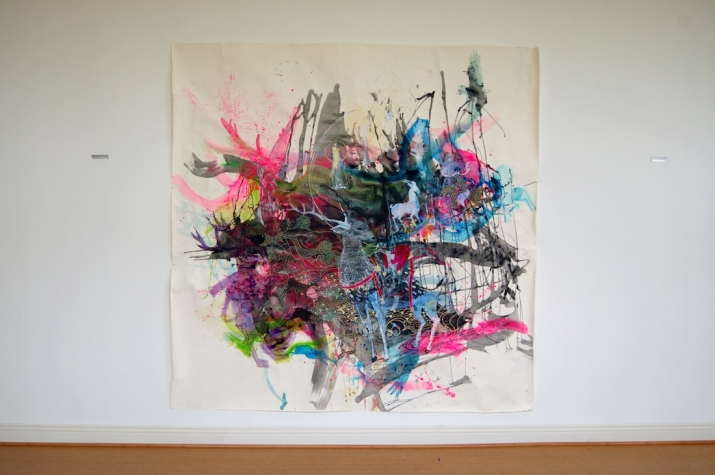 Shika Mandara, by Wakana Kimura. 2013, mixed media. Image courtesy of the artist
Shika Mandara, by Wakana Kimura. 2013, mixed media. Image courtesy of the artistAlthough much of Kimura’s work is large, she also works on the scale of a postcard, and these tiny paintings are no less spiritual in their simplicity and meditative quality. Painted as her daily artistic practice, these 4 x 6-inch works are gems of color, form, and patterning, and like her larger works, invite viewers to look more closely. Rendered in a broad palette ranging from DayGlo pinks and greens to muted earth tones, each painted form is different, and Kimura’s meticulous texturing with tiny dots lends them a uniquely patterned skin. Yet, they are all a variation on a circle, sometimes becoming a donut, or a web, or a mysterious window. Like her larger works, they build and intertwine and begin conversations, inviting the viewer to look beyond the abstraction and find something else hidden deep within.
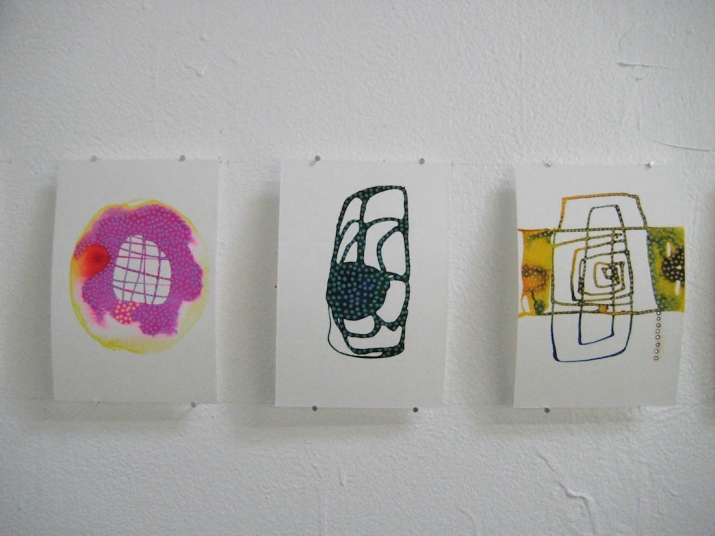 Daily Practice series, by Wakana Kimura (three works). Ongoing, mixed media. Image courtesy of the artist
Daily Practice series, by Wakana Kimura (three works). Ongoing, mixed media. Image courtesy of the artistSee more














